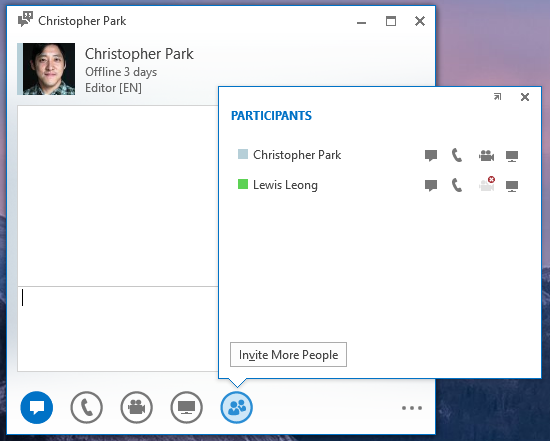

#WHAT IS LYNC WEB APP PLUG IN WINDOWS#
The Feature Pack XenApp 6.5 2 and XenDesktop introduced 7.0 Releases Local App Access, sometimes described in the blogosphere as "Seamless Reverse" - a feature Platinum Edition, which makes possible a Windows application locally on the user's device nor do they appear to be integrated with their virtual / published desktop running. Citrix Receiver supports the tracking log Lync geometry used to position the video content (is running on the server) (reproduced on the endpoint) on the Lync client user interface.įor more details on this solution, see the Citrix support article CTX138408. The server-side Lync client exchanges command and control information with the VDI plug-in via a Dynamic Virtual Channel (DVC). So the user interface and business logic layers of the Lync client running on the XenApp / XenDesktop server, but the audio-video processing load is shifted to the Windows device user. The VDI plug-in is the Lync media engine, wrapped in his own. Microsoft embraced Citrix optimized architecture for UC app delivery with the introduction of Lync 2013 VDI plug-in for Windows. And our general HDX RealTime technologies offer a valuable fallback for users on devices without Lync-compatible media engine. This is especially valuable in the case of webcam video, the CPU intensive and therefore expensive, when the video processing is done server side.Ĭitrix supports three optimized solutions for deploying Lync. These optimized solutions "Media Engine" is running on the endpoint rather than on the server. The difference with optimized HDX RealTime solutions that are available today for Microsoft Lync, Cisco Jabber, Vidyo and Avaya one-X is that the media processing load is redirected to the user device. Work Our generic HDX RealTime technologies without any modification or catches in the native client softphone, but as a result of leaving the media processing load on the XenApp / XenDesktop server.

These ensure complementary approaches that virtually any softphone or unified communications (UC) client can be delivered by XenApp or XenDesktop on an ever wider range of devices, while server scalability to maximize.

This url will provide most of the Lync features in a meeting – like file distribution, application & desktop sharing, viewing & presenting powerpoint slides, meeting wide IM etc.

In that case, you will be given a url of the format. Lync Web App only comes into action when you schedule an online meeting. That is the default behaviour and it is normal. If you access the url, you will be given a Lync splash page. While configuring a Lync server, one of the simple urls that get published is. There is nothing that you need to do as an admin to “publish” the feature. Now, as an admin, how do you configure Lync Web App? It is enabled by default. There is no way for your external users to access a website, put their domain credentials in and be presented with their contact list.
#WHAT IS LYNC WEB APP PLUG IN HOW TO#
Read my article on how to implement that here. In short, if you are looking for the same experience as CWA in Lync, you need to integrate Lync with OWA 2010. In Lync 2010, the feature is still there, but is integrated with Exchange 2010 Outlook Web App (OWA). In the OCS 2007 R2 world, users could use Communicator Web Access (CWA) and get a list of their contacts & initiate IMs. The answer is that experience is different with Lync 2010. A common question these days in the various Lync forums – As an admin, how do I configure Lync Web App for my external users and how can they access it?


 0 kommentar(er)
0 kommentar(er)
